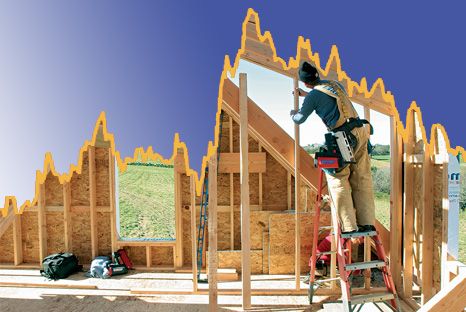
Unlike most industries, where production has risen dramatically over the last two decades, the construction industry remains stuck in a rut. In fact, researchers suggest that construction-worker motivation may be to blame. A Canadian time and motion study of the construction industry concluded that the average amount of work actually executed only made up 51% to 55% of the workday. In other words, for eight hours on the job, only about 4.5 hours were employed–tools in hand–for productive labor.
Why? While other industries have enjoyed improvements in worker productivity (such that today the United States ranks among the top five nations internationally in measures of worker productivity) in the U.S. construction industry, worker productivity has remained negative, or declining since 1967. This year, overall worker productivity increased 1.6% in the United States while hours worked decreased .5%, according to the latest bulletin form the Bureau of Labor Statistics. This is good news for the economy, as wages have only increased 1.4% meaning that overall worker productivity outstrips wage inflation. In construction, productivity decreased -0.5% while wages have increase 0.5%. For single-family construction, the trend is much worst. Between 1987 and 2011, homebuilders experienced a steady -1.4% decline in annual worker productivity (more recent figures were not available at the BLS), coupled with steady increase in wages (interrupted only through the 2008-2010 recession when wages declined slightly).
How to Increase Productivity
As an industry, our workers are less and less productive, and more and more expensive. The research literature includes 35 studies that site lagging worker motivation as the culprit in both the labor shortage in the construction industry and the steady drop in productivity. Researchers outlined five broad areas that must be addressed within the industry–in other words, within each construction company–to motivate workers and increase output.
- Employee development: (a) job advancement; (b) variety of knowledge; (c) participative decision-making; (d) high level of knowledge; (e) developing competencies; (f) sense of achievement.
- Work climate: (a) variety of tasks; (b) social interaction; (c) feedback from work; (d) significant job; (e) communication flow.
- Perceived equity: (a) adequate pay; (b) adequate recognition; (c) freedom at work; (d) feedback from colleagues.
- Work objectivity: (a) complete piece of work; (b) clarity of goal.
- Job security: (a) long term employment.
But perhaps the most telling component that researchers found lacking was not in the workers, but in management. Construction company owners and managers do not enjoy training in, and hence do not understand the subtle dynamics of motivational concepts. Concepts that in many industries are well known at the level of the human resources manager, who works hand in hand with production managers to establish worker incentives and workplace cultural and environmental benefits.
The one thing we have going for us as an industry, is the work itself. Researchers found that building is its own reward, and that managers can leverage this.
“Specifically, management should be developed towards healthy worker attitudes, administering praise, and building respect and for the satisfaction of self-fulfilled needs.” (Journal of Construction Engineering, Volume 2014 (2014), Article ID 703084.)
The means to build “healthy worker attitudes” is fairly straightforward. Managers need to provide steady work; careful, compatible work-crew staffing; exercise team-building skills; develop appropriate team and individual production goals; and of course, provide financial incentives for achieving them.
Anyone, but especially someone who came up in the construction industry, as I have–in an environment that often is characteristically low on social graces and psychological finesse–may do well to take a course in industrial psychology that covers elements of human behavior and motivation theory.
Industrial psychologists recognize five basic types of individuals and the complex motivators that can act a productivity incentives.
Types of individuals:
- Rational-economic man: motivated by economic incentives
- Social man: motivated by social needs and interaction with fellows
- Self-actualized man: motivated by autonomy and independence
- Complex man: motivated by economic, social, and autonomous needs
- Psychological man: motivated by a mixture of complicated factors. (Mansfield and Odeh)
Although a paucity of studies about motivating construction workers leads researchers to conclude that “more studies are needed”–and this is often the unsatisfying conclusion of researchers, “we need more research”–here’s a list of practical things these selfsame researchers suggeast that you should consider when developing a program to motivate your workers:
Significant motivators:
- Employee attitudes can be positively influenced through staff-orientation programs and an overall atmosphere of trust.
- Achievement challenges are easily built into project work.
- Appreciation for effort should be clearly expressed through a variety of means.
- Responsibility reduces boredom and frustration, if work is properly allocated.
- Money acts as a strong or weak motivator, according to economic circumstances.
- Advancement possibilities are reduced for employees where work is short-term or overspecialized.
- Participation in decision making can generate a strong commitment from employees.
- Competition stimulates innovation and affects greater output.
- Social relationships at work are improved by company-sponsored events and courses. (Mansfield and Odeh)
Pretty obvious set of suggestions, but often overlooked while we focus on bids, contracts, plans, and customer issues. But you may get more done on the jobsite by building a strong team of highly motivated workers.
Fine Homebuilding Recommended Products
Fine Homebuilding receives a commission for items purchased through links on this site, including Amazon Associates and other affiliate advertising programs.

Affordable IR Camera

Reliable Crimp Connectors

8067 All-Weather Flashing Tape



























